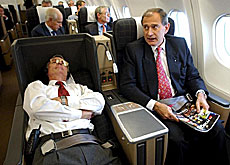Effects of restructuring felt at Swiss

Swiss, the national carrier, says it carried fewer passengers last year, but the load factor on its flights increased over the same period.
The company is in the midst of a cost-cutting programme that has seen it slash jobs and reduce its fleet and network in an attempt to reach profitability.
The airline carried 10.66 million passengers in 2003, down by about a million over the previous year’s figures.
But the occupancy rate on board its flights rose to 72.4 per cent from 71 per cent in 2002.
Swiss said the results from the fourth quarter of last year were “especially encouraging”. Around 2.4 million passengers boarded the company’s flights during that period, with the seat-load factor hitting 75 per cent.
Improved performance
The airline pointed to its new European low-cost concept and the cutbacks in its schedule as two factors that had helped improve performance in the last quarter of 2003.
Seat-load factors in Europe and on intercontinental flights improved, with Africa the weakest region.
Frédéric Plassel, an aviation specialist at the business weekly, “Cash”, told swissinfo the improved load factor was hardly surprising.
“Swiss cut its flight offer substantially, by one-third in Europe and one-tenth elsewhere,” he said. “But the load factor is less important than how much the company earns on each seat, and we won’t know that until March.”
Network cuts
The company reduced the number of its destinations from 96 to 71 when it introduced its winter timetable in October, with 79 aircraft operating the network instead of 108.
Swiss announced in June it had reduced its costs to avoid the fate of its predecessor, Swissair, which collapsed in 2001. The airline said around one-third of its workforce – 3,700 employees – would be laid off, .
“It is hard to say if their strategy is working,” said René Lüchinger, editor-in-chief at the business magazine, “Bilanz”.
“They are trying to sell themselves as a low-cost airline in Europe and as a high-class airline elsewhere, which is very difficult.”
The company said that the war in Iraq, the Sars epidemic and the sluggish economy affected passenger figures last year, especially in the Middle and Far Eastern markets.
It added that competition from low-cost carriers also eroded seat numbers during the early part of the year.
Cash shortage
Plassel said that while Swiss’s situation looked like it was improving, the company was still not out of the woods. Financially, the airline is still on shaky ground and it needs fresh cash.
According to unofficial figures, Swiss still had SFr480 million ($389 million) available at the end of November.
“The company has little in the way of financial cover,” said Plassel. “The time when Swiss may not be able to pay its bills is getting closer.”
The Swiss government has refused to inject any more money into the company and the airline has been in talks for months with Swiss banks UBS and Credit Suisse, as well as foreign institutions, to get new loans.
A deal had been expected by November, but the deadline passed without any agreement.
Number crunching
“They need SFr500 million to stay afloat,” Lüchinger told swissinfo. “But the banks are having trouble approving this loan.”
Swiss is pinning some of its hopes on the Oneworld aviation alliance, which it will join in the coming months. The company reckons membership could generate up to SFr100 million in extra sales.
However, Lüchinger warns it won’t be a solution to all the airline’s problems.
“Most of those joining Swiss flights will be connecting passengers who don’t generate much income for the company,” he said.
And then there are more fundamental problems that Swiss shares with its predecessor, according to Lüchinger.
“The home market is simply too small and the company has too many aircraft,” he said. “This still hasn’t been dealt with.”
swissinfo, Scott Capper
Swiss carried 10.66 million passengers in 2003, about one million less than the previous year.
The load factor was 72.4 per cent, up from 70.7 per cent in 2002.
On European flights, 59.6 per cent of all seats were occupied, while it was 78 per cent on intercontinental flights.

In compliance with the JTI standards
More: SWI swissinfo.ch certified by the Journalism Trust Initiative











You can find an overview of ongoing debates with our journalists here . Please join us!
If you want to start a conversation about a topic raised in this article or want to report factual errors, email us at english@swissinfo.ch.